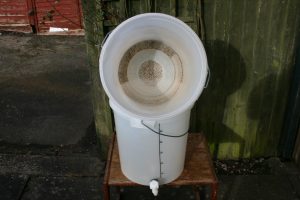First Attempts
 My first efforts with brewing my own beer at home started ambitiously with the all-grain method. This was back in the 1990’s. The results were at best average, and only occasionally did I achieve anything like an enjoyable final product. Unfortunately, with the benefit of hindsight, my equipment was woefully inadequate. My mash tun was constructed from two polypropylene (plastic) fermenting bins, one inside the other, with lots of small holes drilled at the bottom of the inner one (these bins were slightly tapered, so one bin could fit inside the other, see photo). The outer bin had a tap. Into the outer bin I made a hole (near the bottom), to install an electrical heating element (for heating the mash and for boiling). In an attempt to maintain a constant mash temperature for an hour I wrapped these two bins in a thick winter coat! So I had no means of controlling the temperature during the mash, no practical way of recirculating the hot wort during the mash, and the bins were difficult to keep clean and not very durable. For sparging, I lifted the inner bin clear of the outer, and suspended it above. Sparge water was heated in a kettle, and the amount (and temperature) of sparge water wasn’t measured at all – I just sparged until I had sufficient water in the outer bin for boiling. The outer bin (with its electrical heating element) then became the boiler. This all worked okay, but was difficult to clean after use. My fermenting vessel was also a plastic bin, with a lid and airlock.
My first efforts with brewing my own beer at home started ambitiously with the all-grain method. This was back in the 1990’s. The results were at best average, and only occasionally did I achieve anything like an enjoyable final product. Unfortunately, with the benefit of hindsight, my equipment was woefully inadequate. My mash tun was constructed from two polypropylene (plastic) fermenting bins, one inside the other, with lots of small holes drilled at the bottom of the inner one (these bins were slightly tapered, so one bin could fit inside the other, see photo). The outer bin had a tap. Into the outer bin I made a hole (near the bottom), to install an electrical heating element (for heating the mash and for boiling). In an attempt to maintain a constant mash temperature for an hour I wrapped these two bins in a thick winter coat! So I had no means of controlling the temperature during the mash, no practical way of recirculating the hot wort during the mash, and the bins were difficult to keep clean and not very durable. For sparging, I lifted the inner bin clear of the outer, and suspended it above. Sparge water was heated in a kettle, and the amount (and temperature) of sparge water wasn’t measured at all – I just sparged until I had sufficient water in the outer bin for boiling. The outer bin (with its electrical heating element) then became the boiler. This all worked okay, but was difficult to clean after use. My fermenting vessel was also a plastic bin, with a lid and airlock.
For a keg I used a plastic barrel (eg. a King Keg), which had an S30 adapter on top for injecting CO2. It wasn’t possible to get a sufficiently high pressure for forced carbonation though (these sort of kegs can only be pressurised up to about 15 psi).
Very occasionally (probably accidentally) I got a reasonable result, but unsurprisingly my beers were mostly flat with not a very pleasing flavour. I quickly learnt how critical the mash temperature is. And to cap it all, this was when my sons were still at home, and my youngest son Rob regularly complained about the smell of beer brewing in the house (ironically, Rob, now in his mid 30’s, really enjoys his beers!) So this phase in my beer brewing history didn’t last long. The results just didn’t seem worth all of the effort.
Nowadays
 I took up the hobby again at the beginning of 2020, this time deciding to get a stainless steel mash tun and boiler. Stainless steel is better than plastic for sanitising, it’s ‘food grade’, and it’s more durable. I also invested in:
I took up the hobby again at the beginning of 2020, this time deciding to get a stainless steel mash tun and boiler. Stainless steel is better than plastic for sanitising, it’s ‘food grade’, and it’s more durable. I also invested in:
- a proper stainless steel hot liquor tank, to hold the sparging liquor (and control its temperature),
- a stainless steel hop basket, to hold the hops during the boil,
- a stainless steel fermenting vessel,
- a ‘Cornelius’ keg, so that I could force-carbonate the beer,
- a fridge in which to cool the beer to the correct serving temperature (about 10°C, like a traditional beer cellar).
I’m pleased to say that my new equipment gives me consistently good beer, which is clear, and has good ‘body’ (ie. is sufficiently sparkling) with a good ‘head’! Much more rewarding!
